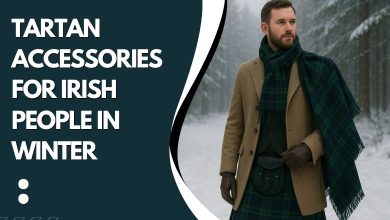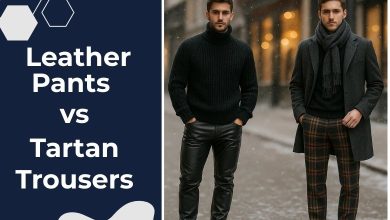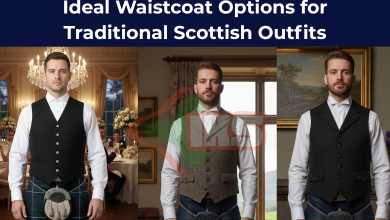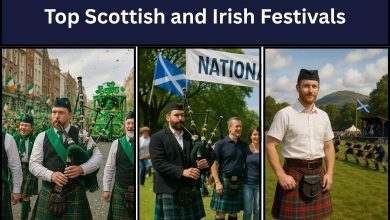Ideal Waistcoat Options for Traditional Scottish Outfits
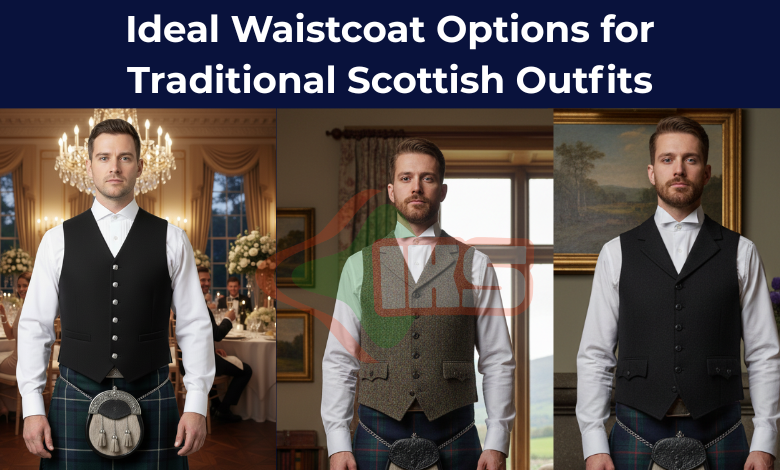
Scottish kilt outfits have many parts with unique functions and they are worn differently and one among them is the waistcoat that mostly is worn with the matching kilt jackets. The waistcoat further has various types, and this guide is meant to explore them. In addition to different waistcoat options, this article will discuss some tips to choose the right one and ways to get its measurement. Before we start, let’s highlight the role of the waistcoat in Scottish outfits first.
Table of Contents
ToggleThe Role of the Waistcoat in Highland Dress
The waistcoat completes the whole look and completes the dress by adding a flair to it. Their use is consistent in formal events while a bit lower in casual settings. However, the selection of the right fabric is crucial in both formalities. In addition to enhancing the look, a waistcoat also ties all the accessories, such as ties, shirts, and coats that match.
Waistcoat vs. Kilt Jacket: Understanding the Difference
Many consider the waistcoat and kilt jackets to be the same things, but it is just a misconception. They are often paired together but are different things. Here is a detailed comparison table of their differences.
| Aspects | Kilt Waistcoat | Kilt Jackets |
| Purpose | Worn as a mid-layer, typically under a jacket | Outerwear worn over a shirt (and sometimes a waistcoat) |
| Placement | Worn beneath the jacket, over a shirt | Worn on top of the waistcoat and shirt |
| Formality | Part of both formal and semi-formal attire | Usually designed for formal or semi-formal events |
| Design Feature | Sleeveless, buttoned front, fitted shape | Sleeved, tailored, often with ornate buttons and epaulettes |
| Material | Typically made of wool, tweed, or silk | Usually heavier materials like barathea or tweed |
| Common Styles | Prince Charlie waistcoat, Argyle waistcoat | Prince Charlie jacket, Argyle jacket, Braemar jacket |
Types of Waistcoats for Kilt Outfits
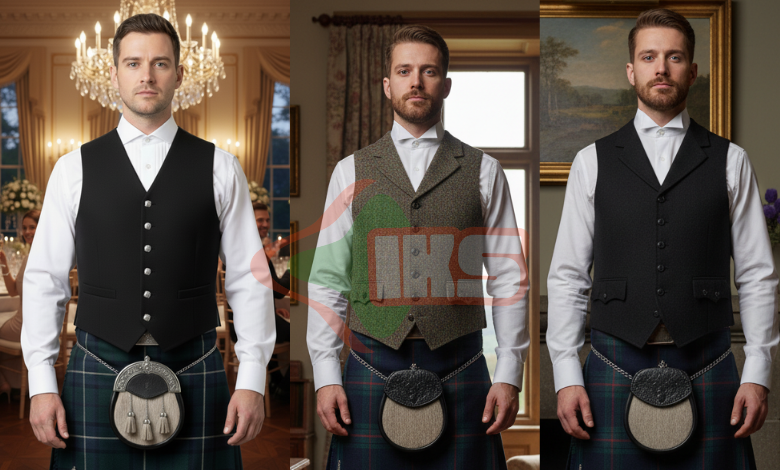
The differences between jackets and waistcoats might be clear now. Let’s discuss our primary topic now, which is the types of waistcoats. Many assume only Prince Charlie and Argyll waistcoats to be suitable with kilts. They are right, but these are the traditional ones, while many others are also worn today.
Traditional Prince Charlie Waistcoat
This waistcoat is specific to the classic Prince Charlie outfit, which is certain for formal settings. It often does not have many colors, and black and blue are worn with a matching jacket. A sharp cut and 5 shiny buttons enhances its overall look. A Prince Charlie’s waistcoat usually has two pockets on the front and an internal pocket to carry small items.
Argyll Waistcoat
Let’s talk about the Argyll waistcoat, which is a versatile option and suitable for both formal and relaxed events. Similar to the previous one it has 5 buttons and is also made of barathea wool while experts also use tweed fabric occasionally.
Tweed Waistcoat
Those who need to wear a waistcoat during the daytime events, a tweed waistcoat is an appropriate option. This vest brings texture and earthy tones to the outfit and works great with matching tweed jackets. The rough surface of the fabric and its unique visuals add warmth and tradition, especially in outdoor settings. The number of buttons can vary from 3 to 5, while the pockets can be with or without flaps.
Doublet Waistcoats
Like the Prince Charlie clothing, the doublet is considered to be a formal vest and a suitable option for evening events and ceremonies. It has a rich design, sometimes with ornate fastenings or decorative trim. The doublet waistcoat has close fitting and is made according to the men’s body to provide structure and warmth. Moreover, it has many options to fasten it, including buttons, laces, and hooks.
Choosing the Right Waistcoat for the Occasion
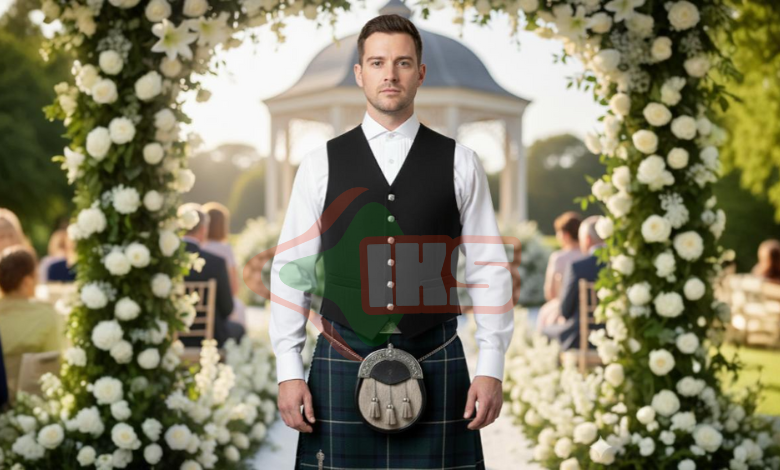
Now that you know the different types of kilt waistcoats and their features and events to wear them to. Regarding the selection of an ideal waistcoat, you must keep a few considerations in mind to make the right decision.
Color and Fabric Coordination: The color of your waistcoat and other kilt accessories should match. Maintain the difference between matching and clashing. Moreover, ensure opting for the same fabric that is used in the jacket.
Event’s Formality: Do not overlook the event’s formality while choosing a waistcoat and pair of suitable options. A tweed vest is not right for cultural events; similarly, a Prince Charlie waistcoat cannot be worn casually. Wearing the wrong vest looks like disrespecting the attire.
Design and Pattern: The color and types of waistcoats are not the only considerations that match with other accessories. You should also consider lapel style, button number, and pocket detailing to match the occasion and personal style.
How to Measure for the Perfect Waistcoat Fit
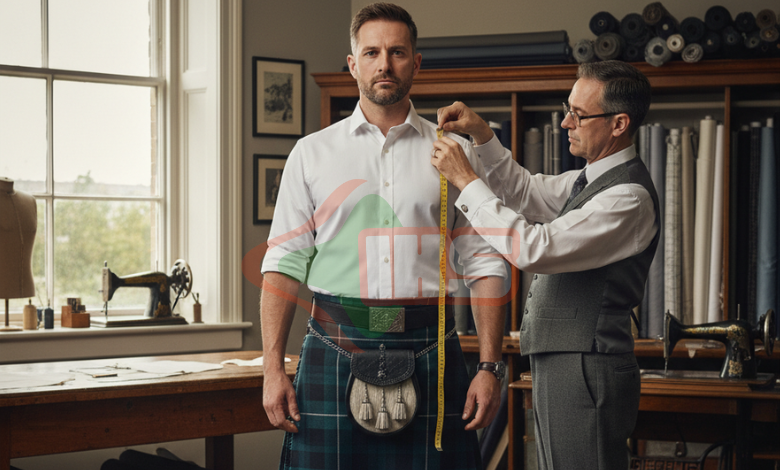
Usually there are three primary aspects when you have to get the perfect measurements of your vest fit, and they are chest, waist, and back length. While measuring yourself, the waistcoat should be close-fitting. Similarly, you should prevent pulling or gaping, but it should not be so tight as to maintain easy movement. Follow the given tips to get the accurate measurement.
- Start the process by wrapping the tape measure around the widest part of your chest, keeping it level.
- Do not measure your waist from a random point, but place the tape around the circumference of your waist or around the belly button.
- Measure from the base of your neck and take the tape down to your natural waistline.
- Get a helper to measure from the outside edge of one shoulder across your back to the outside edge of the other shoulder.
Common Mistakes to Avoid
People often make mistakes while choosing or wearing waistcoats that are signs of inappropriateness in the attire. You must know them to save you money and get the desired product.
- People usually wear traditional vests on casual events, similarly, modern vests with formal kilts. This approach not only impacts the overall silhouette but is also a sign of disrespecting the attire.
- A waistcoat looks good if it fits you snugly. Some choose vests that are too tight or loose, which look awkward.
- Patterned waistcoats are common today, but they are usually worn with both plain and tartan kilts. Individuals often overlook the patterns of clothing, and it results in clashing the patterns.
- Over-accessorizing the vests is also a common practice that conflicts with the legacy of traditional items.
Buy Premium Quality Waistcoats at Irish Kilt Shop
Are you looking to buy a premium-quality waistcoat but unsure about a reliable store? Save yourself time and approach the Irish Kilt Shop directly to buy customized waistcoats, jackets, men’s kilts, and other accessories. Other than customization services, we provide all of our premium-quality products at very affordable prices. So, explore our store today and buy whatever you want.
FAQs About Waistcoats to be Worn with Kilt Jackets
Can I wear a waistcoat without a kilt jacket?
Absolutely, wearing a waistcoat without a jacket is possible, but be sure to do it in casual events, as formal events follow a proper dress code.
Can I wear a waistcoat with utility or contemporary kilts?
Yes, you can do it, but do not overlook the event’s theme because modern kilts are not suitable for ceremonial events.
Do women have waistcoats specifically designed for them?
Even though kilt vests are traditionally specific to men, some variations are considered unisex designs. Moreover, women also have their specific ones that come with slim fitting according to their body type.
Do you need to button all the buttons on a kilt waistcoat?
Though people close all buttons, leaving the button undone is also a traditional practice.

